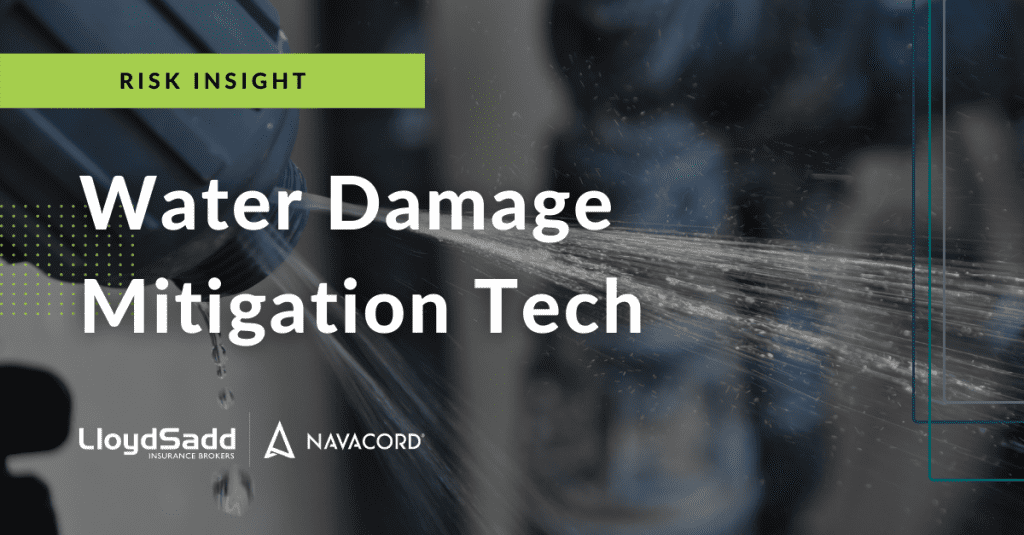Water Damage Mitigation Tech

According to the Canadian Institute of Actuaries, damage from water and other climate related perils have emerged to replace fire and theft as the largest source of claims costs for Canada’s property and casualty insurers. There is a large amount of data circulated concerning the frequency of water damage claims. An article in the Canadian Underwriter outlining the high frequency of water claims indicates “there is a much higher frequency of claims when it comes to water damage than other claims.” Water damage claims are not occurring only in aging buildings, “relatively modern systems can also fail due to improper installation, poor product quality or connection types.” As a result, insurance appetite and capacity for commercial properties as well as rates and deductibles have shifted significantly.
Water damage mitigation systems are a risk management solution for consideration and the focus of this document. These systems are designed to identify leaks and/or abnormal water flow and either manually shut water off or alert key people to investigate and address the leaks. Early identification of water leaks or excessive water flow can lead to significant savings and reduce the frequency and severity of water damage claims. Properties are reviewed by Underwriters who decide on the merits of controls and determine capacity, apply ratings and deductibles. Given increased frequency and cost of water damage losses, water damage mitigation systems are now more attractive to property and casualty insurers.
Not all water damage mitigation systems are designed the same. Benefits of water damage mitigation systems installed in buildings may include:
- Early identification of leaks
- Notification to key people of leaks or excessive water flow
- Early shut-off of water to prevent high severity losses
- Water consumption information that could lead to operational savings
- Temperature, humidity, motion, or light monitoring which could provide operational insight to owners and managers.
- Protection of critical building equipment such as elevators and mechanical equipment
- Real time data related to operational status of detection equipment and water usage
Key elements to consider for determining the types and number of components of a water mitigation system include the number of floors, number of suites, number of risers, the cost of the equipment, installation cost and monthly monitoring costs. Benefits for investing in these systems to consider should include possible insurance savings from reduced number of claims as well as operational savings.
Based on insurance and property experience, the following areas should be considered for mitigation efforts and ROI analysis:
- Electrical and Mechanical Rooms
- HVAC equipment
- Bathrooms
- Risers
- Cooling Towers
- Elevator pits
- Kitchens
- Laundry Rooms
Water Damage Mitigation System Attributes
There are many manufacturers, components, and systems available today. With the abundance of choices available, it is important to understand key components of water mitigation systems.
Key components include:
- Leak detectors: Leak detectors sense the presence of water and can either alert a person locally (beep/bell); or send a signal to alert a person remotely. Leak detectors can be wired or wireless. These detectors can be plugged into building power, battery powered or both. Beyond leak detection, some detectors also include temperature, humidity, motion, and light detection. Detectors vary in shape and size. Some leak detectors can be programmed to send an alert to an automatic shut-off device for immediate closure of valves. See shut-off device below.
- Flow Detection devices: Flow detection devices measure or detect the flow of water. Flow detection devices may be installed “in-line” by a plumber, or they may be placed on a meter to measure flow. Flow detection allows a person to understand consumption information and can also identify abnormalities in water usage that should be investigated. Some flow detectors can be programmed to send an alert to an automatic shut-off device for immediate closure of valves if an abnormal amount of water usage is detected. See shut-off device below.
- Shut-off Device: Shut-off devices are easily installed on top of existing valves by anyone or are installed “in-line” by a plumber. Some shut-off device may be activated automatically following alert signals from a leak detector, or a flow detector. They may also be manually shut off by some-one who identifies a leak that has gone undetected. Finally, they can be shut off remotely by an authorized owner or manager through the system network.
- Dashboards and Apps: The combination of leak and flow detectors as well as shut off devices may be included in a network. The devices send data to the network and manufacturers provide information to users identifying details such as location of each device (leak detectors, flow detectors, shut offs) power level, consumption information, detection of leak status, alerts, temperature, humidity and more. This information may be specific to a single property or may include aggregate information for all properties where these devices are installed.
- Communication equipment: Network systems that allow for remote alerts require communication equipment. This allows the system to send signals via cellular, WiFi or ethernet connections in the building.
While these systems may include a variety of components, it is important to identify whether all components are required at a specific location to determine the needs for detection and/or shut-off throughout a building.
Lloyd Sadd Risk Services is available to discuss the nuances of these systems and provide guidance using our knowledge and experience with manufactures to assist you in your analysis.
To download the insight, click here: Risk Insight_Water Damage Mitigation Tech